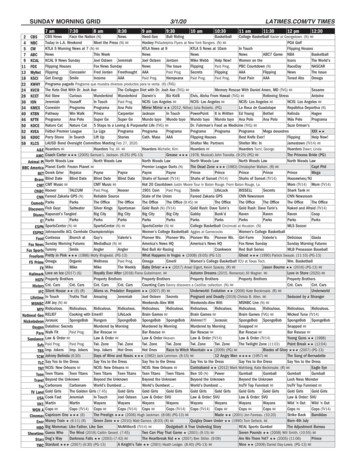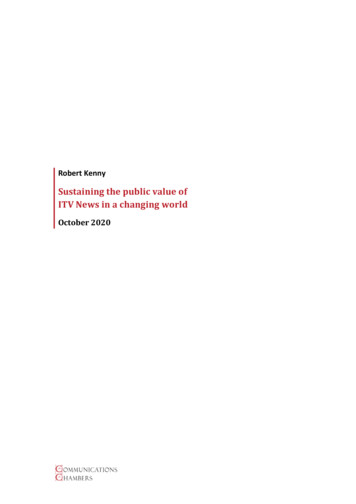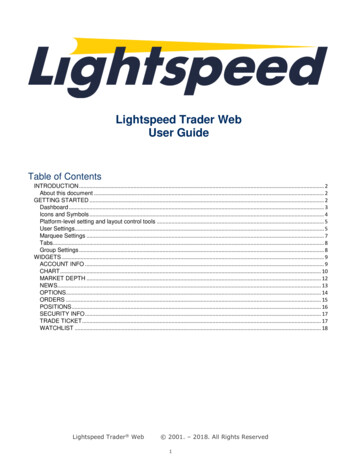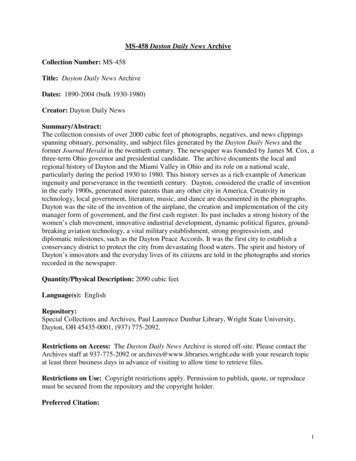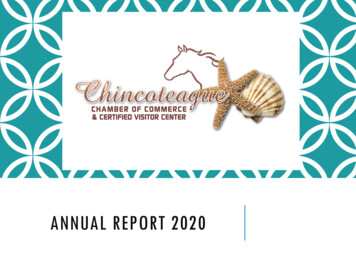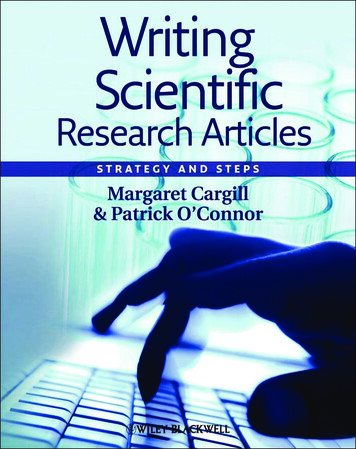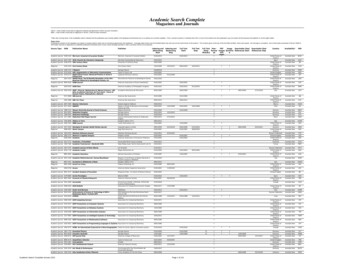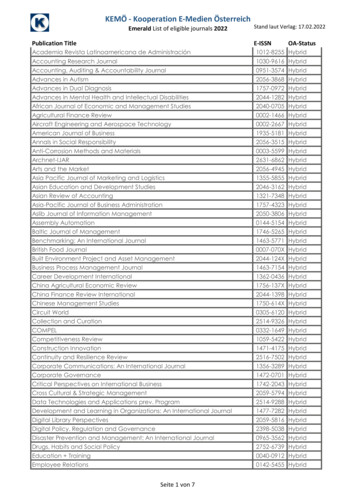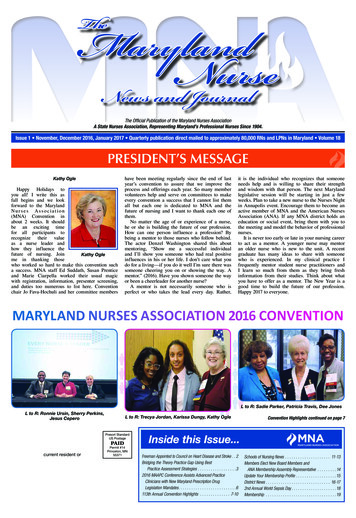
Transcription
News and JournalThe Official Publication of the Maryland Nurses AssociationA State Nurses Association, Representing Maryland’s Professional Nurses Since 1904.Issue 1 November, December 2016, January 2017 Quarterly publication direct mailed to approximately 80,000 RNs and LPNs in Maryland Volume 18President’s MessageKathy OgleHappy Holidays toyou all! I write this asfall begins and we lookforward to the MarylandNu rses Association(MNA) Convention inabout 2 weeks. It shouldbe an exciting timefor all participants torecognize their valueas a nurse leader andhow they influence thefuture of nursing. JoinKathy Ogleme in thanking thosewho worked so hard to make this convention sucha success. MNA staff Ed Suddath, Susan Prenticeand Marie Ciarpella worked their usual magicwith registration, information, presenter screening,and duties too numerous to list here. Conventionchair Jo Fava-Hochuli and her committee membershave been meeting regularly since the end of lastyear’s convention to assure that we improve theprocess and offerings each year. So many membervolunteers help and serve on committees to makeevery convention a success that I cannot list themall but each one is dedicated to MNA and thefuture of nursing and I want to thank each one ofthem.No matter the age of or experience of a nurse,he or she is building the future of our profession.How can one person influence a profession? Bybeing a mentor to those nurses who follow behind.The actor Denzel Washington shared this aboutmentoring, “Show me a successful individualand I’ll show you someone who had real positiveinfluences in his or her life. I don’t care what youdo for a living—if you do it well I’m sure there wassomeone cheering you on or showing the way. Amentor.” (2016). Have you shown someone the wayor been a cheerleader for another nurse?A mentor is not necessarily someone who isperfect or who takes the lead every day. Rather,it is the individual who recognizes that someoneneeds help and is willing to share their strengthand wisdom with that person. The next Marylandlegislative session will be starting in just a fewweeks. Plan to take a new nurse to the Nurses Nightin Annapolis event. Encourage them to become anactive member of MNA and the American NursesAssociation (ANA). If any MNA district holds aneducation or social event, bring them with you tothe meeting and model the behavior of professionalnurses.It is never too early or late in your nursing careerto act as a mentor. A younger nurse may mentoran older nurse who is new to the unit. A recentgraduate has many ideas to share with someonewho is experienced. In my clinical practice Ifrequently mentor student nurse practitioners andI learn so much from them as they bring freshinformation from their studies. Think about whatyou have to offer as a mentor. The New Year is agood time to build the future of our profession.Happy 2017 to everyone.Maryland Nurses Association 2016 ConventionL to R: Sadie Parker, Patricia Travis, Dee JonesL to R: Ronnie Ursin, Sherry Perkins,Jesus CeperoL to R: Trecya Jordan, Karissa Dungy, Kathy OglePresort StandardUS PostagePAIDcurrent resident orPermit #14Princeton, MN55371Convention Highlights continued on page 7Inside this Issue.Freeman Appointed to Council on Heart Disease and Stroke. . 2Bridging the Theory Practice Gap Using BestPractice Assessment Strategies . . . . . . . . . . . . . . . . . . 32016 MAAPC Conference Assists Advanced PracticeClinicians with New Maryland Prescription DrugLegislation Mandates. . . . . . . . . . . . . . . . . . . . . . . . . . .6113th Annual Convention Highlights . . . . . . . . . . . . . . . 7-10Schools of Nursing News . . . . . . . . . . . . . . . . . . . . . . 11-13Members Elect New Board Members andANA Membership Assembly Representative . . . . . . . . . 14Update Your Membership Profile. . . . . . . . . . . . . . . . . . . 15District News . . . . . . . . . . . . . . . . . . . . . . . . . . . . . . 16-172nd Annual World Sepsis Day . . . . . . . . . . . . . . . . . . . . .18Membership . . . . . . . . . . . . . . . . . . . . . . . . . . . . . . . . . 19
Page 2 The Maryland Nurse News and JournalFreeman Appointedto Council on HeartDisease and StrokeLoisA.FreemanDNP,CRNP,CCRNwho is the sole providerin the Home TelehealthProgram at the MarylandVeterans Administration(VA) Healthcare Systemin Baltimore, MD, hasbeen appointed to theCouncil on Heart Diseaseand Stroke Prevention byGovernor Hogan.The Council on HeartLois FreemanDiseaseandStrokeDNP, CRNP, CCRNPrevention acts in anadvisory capacity to the Department of Health andMental Hygiene. The Council works collaborativelywith a broad range of agencies and organizations todevelop and promote educational programs in theprevention, early detection, and treatment of heartdisease and stroke, targeted to high-risk populationsand to geographic areas where there is a highincidence of heart disease and stroke.The Advisory Council also establishes guidelinesfor DHMH that cover: Primary prevention Detection Case finding Diagnosis Diagnostic work up Therapy Long term management Any other services that the Advisory Councilthinks should be coveredOnce every 2 years, the Advisory Council submitsa report to the Governor evaluating heart disease andstroke prevention, education, and treatment programs.The Advisory Council consists of 25 membersappointed by the Governor. Member terms are forfour years.Congratulations, Lois!Save the Date!Nurses Night inAnnapolisMonday,February 20, 2017November, December 2016, January 2017PUBLICATIONThe Maryland Nurse Publication ScheduleIssueMaterial Due to MNAFebruary, March, April 2017January 2017The Maryland Nurse is the official publication of theMaryland Nurses Association. It is published quarterly.Annual subscription is 20.00.MISSION STATEMENTThe MNA Mission Statement and Values adoptedOctober 2014The Maryland Nurses Association, the voice for nursing,advocates for policies supporting the highest qualityhealthcare, safe environments, and excellence in nursing.Our core values: Camaraderie, Mentoring, Diversity,Leadership, and RespectArticles and Submissionsfor Peer ReviewThe Maryland Nurse welcomes original articles andsubmissions for publication. All material is reviewed by theeditorial board prior to acceptance. Once accepted, manuscriptsbecome the property of The Maryland Nurse. Articles may be usedin print or online by the Maryland Nurses Association and will bearchived online. It is standard practice for articles to be publishedin only one publication. If the submission has been previouslydistributed in any manner to any audience, please include thisinformation with your submission. Once published, articles cannotbe reproduced elsewhere without permission from the publisher.Preparing the Manuscript:1. All submissions should be word-processed using a 12 pointfont and double spaced.2. A title page should be included and contain a suggestedtitle and the name or names of the author(s), credentials,professional title, current position, e-mail, mailing address,telephone contact, and FAX number, if applicable. Authorsmust meet the requirements for authorship. Contributorswho do not meet the criteria for authorship may be listedin an acknowledgements section in the article. Writtenpermission from each person acknowledged must besubmitted with the article.3. Subheadings are encouraged throughout the article toenhance readability.4. Article length should not exceed five (5) 8 ½ X 11 pages(1500-2000 words).5. All statements based on published findings or data shouldbe referenced appropriately. References should be listedin numerical order in the text and at the end of the articlefollowing the American Psychological Association (APA)style. A maximum of 15 references will be printed with thearticle. All references should be recent–published within thepast 5 to 7 years–unless using a seminal text on a given subject.6. Articles should not mention product and service providers.Editing:All submissions are edited for clarity, style and conciseness.Referred articles will be peer reviewed. Comments may be returnedto the author if significant clarification, verification or amplificationis requested. Original publications may be reprinted in TheMaryland Nurse with written permission from the original authorand/or publishing company that owns the copyright. The sameconsideration is requested for authors who may have original articlespublished first in The Maryland Nurse. Additionally, once theeditorial process begins and if a submission is withdrawn, the authormay not use The Maryland Nurse editorial board review commentsor suggestions to submit the article to another source for publication.Authors may review the article to be published in its finalform. Authors may be requested to sign a release form prior topublication. The Maryland Nurses Association retains copyrightson published articles, subject to copyright laws and the signing ofa copyright transfer and warranty agreement, and may transfer thatright to a third lished by:Arthur L. DavisPublishing Agency, Inc.Board of DirectorsPresidentKathleen Ogle, PhD, RN,FNP-BC, CNESecretaryJosephine Fava Hochuli,MSN, RNPresident-ElectTreasurerBarbara Biedrzycki, PhD,Karen Evans, MSN,RN-BC, SD-CLTC RN, MSN, CRNP, AOCNP DirectorsJaime Striplin, BSNCharlotte Wood, PhD, RN, MSN, MBAJanice Clements, BSN, MSN, RNElizabeth MacKessy-Lloyd, MS, MA, RNCindy Bennoit, BSN, RNDebra Disbrow, MSN, RN, ONCDee Jones, MSN, RNDistrict PresidentsDistrict 1Jeannie Seifarth, PhD, RN, PMHCNS-BCDistrict 2Nayna Philipsen, JD, PhD, RN, CFE, FACCEDistrict 3Donna Downing-Corddry, BSN, RN, CAPADistrict 4VacantDistrict 5Harolda Hedd-Kanu, RN-BCDistrict 7Dee Jones, MSN, RNDistrict 8 Sandy Vegh, RN, MSNDistrict 9Melissa Henderson, RNMEMBERSHIP ASSEMBLYMNA OfficerRepresentative:First Alternate:Second Alternate:Third Alternate:Kathy Ogle,PhD, RN, FNP-BC, CNEKaren E. B. Evans, MSN, RN-BC, SD-CLTCBarbara A. Biedrzycki,PhD, RN, MSN, CRNP, AOCNP Linda Cook, PhD, RN, CCRN, CCNSMNA Member-At-Large Rosemary Mortimer,Representative: RN, MS, MSEd, CCBEFirst Alternate:Denise Moore, PhD, APRN-BCSecond Alternate: Christie Simon-Waterman, RN, MSN, CRNPThe Editorial Board of The Maryland NurseCharlotte Wood, PhD, RN, MSN, MBA, EditorBeverly Lang, MScN, RN, ANP-BCNaomi (Bea) Himmelwright–Lamm, EdD, RNDenise A. Moore, PhD, APRN-BCPatricia Travis, PhD, RN, CCRPLinda Cook, PhD, RN, CCRN, CCNSLinda Stierle, MSN, RNCheryl Harrow, DNP, RN, FNP-BC, IBCLCKathleen Ogle, PhD, RN, FNP-BC, CNEIf you are interested in reviewing, reporting, or writing for TheMaryland Nurse, contact us.Contact us at TheMarylandNurse@gmail.com443-334-5110Chief Staff Officer, Ed SuddathFor advertising rates and information, please contact Arthur L.Davis Publishing Agency, Inc., 517 Washington Street, PO Box 216,Cedar Falls, Iowa 50613, (800) 626-4081, sales@aldpub.com. MNAand the Arthur L. Davis Publishing Agency, Inc. reserve the rightto reject any advertisement. Responsibility for errors in advertisingis limited to corrections in the next issue or refund of price ofadvertisement.Acceptance of advertising does not imply endorsement orapproval by the Maryland Nurses Association of products advertised,the advertisers, or the claims made. Rejection of an advertisementdoes not imply a product offered for advertising is without merit,or that the manufacturer lacks integrity, or that this associationdisapproves of the product or its use. MNA and the Arthur L. DavisPublishing Agency, Inc. shall not be held liable for any consequencesresulting from purchase or use of an advertiser’s product. Articlesappearing in this publication express the opinions of the authors;they do not necessarily reflect views of the staff, board, ormembership of MNA or those of the national or local associations.The Maryland Nurse is published quarterly every February,May, August and November for the Maryland Nurses Association,a constituent member of the American Nurses Association, 6 ParkCenter Court, Suite 212, Owings Mills, MD 21117.
November, December 2016, January 2017The Maryland Nurse News and Journal Page 3Bridging the Theory Practice Gap Using Best PracticeAssessment StrategiesCharlotte M. Wood, PhD, MSN, MBA, RN &Ihuoma Ezebuihe, DNP, MSN, MPH, RNThe Institute of Medicine (IOM, 2010) reportindicated that the quality of healthcare in the UnitedStates is less than adequate and borders on beingunsafe. The report implied that broken systemsand flawed methods lead people to make errors or,alternatively failed to prevent errors (p. 2). Since2002, there has been substantial growth in thenumber of nurses produced in the United States.Although the nursing shortage has been prevalentfor many years, the greatest shortage is in nursingknowledge (Buerhaus, 2016).Many hospitals and other acute care facilitieshave benefited from the country’s current economicstatus and the positive shift in the nursing workforce.Consequently, administrators and members ofthe public continue to demand that institutions ofhigher education increase the number of nursingprofessionals with a high level of competence andfocus on safety. The focus and goal of nursingeducators is to close the theory practice gap thatexists between newly licensed registered nurses andexperienced practicing nurses.McGill and Anderson (2014) affirm that the gapin theory and practice reflects the discord betweenthe cognitive ability and proficiency of whatprelicensure nursing students learn and use safelyunder supervision in the practice setting versus theacademic setting. In an attempt to determine theeffectiveness of both didactic and clinical instruction,the teaching learning process must be assessed toensure that achievement expectations and curricularoutcomes are met. Nursing standards and professionalpractice require multidimensional assessmentstrategies to authenticate nursing competencies(Lenburg, et al, 2011). As a result, many schools ofnursing use a combination of evaluation tools todetermine the appropriate assessment needed fordidactic and clinical performance.Both classroom and clinical assessments willprovide insight to the nursing instructor on whetherthe content taught was learned, and how well itwas learned. This is especially important since theteaching learning process is a cycle that includesboth the instructor and the student. The quality ofthe student’s learning is related to the quality of theteaching or teaching strategies used by the nursingeducator (Angelo & Cross, 1993). In order forinstructors to improve what students learn, instructorsmust receive feedback on the instruction given tothe students. In light of this fact, educators typicallyuse two different types of evaluation; formative andsummative evaluations.Formative assessments are completed in anongoing fashion allowing data to be gathered whilethe teaching learning process is being unveiled(Scheckel, 2009). Therefore, formative assessmentsare used to critique student learning, review learningactivities, and identify any difficulties that comeup during the implementation (Scheckel, 2009,p.169). Scheckel (2009) states that the significanceof the formative process lies in whether the studentsdemonstrate problems in achieving the desiredoutcomes for a specific content topic, in addition,the faculty may want to use a different teachingstrategy to improve the effectiveness of the content.The data needed to support a formative assessmentof the current teaching learning process can bereflected in the results of activities such as quizzes,questionnaires, papers, or other classroom assessmenttechniques ogramAn effective clinical tool,and now the law.For more information, visit:www.MarylandPDMP.orgTo register, visit: www.crisphealth.orgIn contrast, a summative evaluation is completedby the faculty at the end of the course or unit ofstudy. When planning the course curriculum, theeducator must consider the type of assessmentrequired to measure specific outcomes, determinelearner readiness, and assess how learners learn.The summative evaluation provides insight onthe student’s learning outcomes, determines theeffectiveness of learning activities and strategies,and assist with the revisions to the planned learningactivities in the course (Scheckel, 2009). Accordingly,learning activities can be included in achievementassessments, and therefore may result in creatingcritical thinking, problem-solving, and contentassessment based on the use of computer-basedexaminations, portfolio’s, clickers, and journaling.Computer-Based ExaminationsMany educators use a traditional means ofevaluation and assessment to measure the student’scognitive competencies, proficiencies, and feelingsBridging the Theory Practice Gap continued on page 4LIVE-SCAN FINGERPRINTINGCJIS-Approved ProviderFBI and State of Maryland Fingerprint Background CheckBy-appointment, and Portable On-Site ServiceTrident Security Group LLCCell: 443-977-7088Email: info@tridentsecuritygroup.comWeb: www.tridentsecuritygroup.comAlso: Notary Public Passport Photos State of Maryland – Approved Firearm Safety Training
Page 4 The Maryland Nurse News and JournalBridging the Theory Practice Gap continued from page 3during and after participation in courses andprograms (Bourke & Ihrke, 2009). In 1994, theNational Council of Licensure Examination forregistered nurses (NCLEX-RN) implemented acomputerized testing format that has resulted inan increasing use of computer based examinationsto prepare prelicensure nursing students for theNCLEX-RN (Gilmer, Murley, & Kyzer, 2003).The NCLEX-RN is the examination given toprelicensure graduate nurses to obtain their licenseto become a registered nurse. One of the primarymethods of assessment is a written or computerbased examination. Computer-based examinationshave provided significant gains for both the facultyand students (Gilmer & et. al, 2003). Some ofthe advantages include flexibility in scheduling,preparation, test analysis and review, location, time,storage, a data repository, and feedback to students(Gilmer & et. al, 2003,).The computer-based examination questions arestructured to address the course objectives andlearning outcomes. The questions are constructedbased on the revised edition of Bloom’s taxonomy ofeducational objectives which is a guide to instructionand evaluation of students (Gronlund & Waugh,2009). Bloom’s taxonomy identifies three domainsof behavior for classifying objectives: Cognitive,psychomotor, and affective (McDonald, 2007). Thecognitive domain is focused on thought processesand consists of the terms, remember, understand,apply, analyze, evaluate, and create (Gronlund &Waugh, 2009). The questions usually encompass thedifficulty levels that span from simple to complexusing the cognitive domain.November, December 2016, January 2017Typically, computer-based examinations areconstructed in a manner that builds on knowledgegained throughout the curriculum from one semesterto the next or, from the first week of the semesterthrough the last. In addition, many computer-basedinstructional programs that are designed and createdallow a degree of learner control. The educatormay consider a computer-based examination thebest method to assess the learning of a studentthat is preparing to take the NCLEX-RN. One ofthe primary goals of the educator is to design anenvironment that elicits the behavior that promoteslearning and provides the desired behaviors necessaryfor the successful sitting for the NCLEX-RN.The educator’s approach must promote andsupport the dignity of the individual and is widelyused throughout the profession of nursing. Thus,this strategy is viewed as a means to value studentfeelings, promote independence, responsibility andaccountability (Vandeveer, 2009). The educator mayalso spend additional time preparing the studentsfor the computer-based examination by usinginstructional time to facilitate the growth of thestudent.The preparation would potentially include usingcase studies, providing positive feedback, and askingquestions to facilitate critical thinking (Vandeveer,2009). The use of portfolios is an alternative methodto testing and is used as a means to assess a learner’sprogression towards meeting course and programoutcomes.of the students’ best works (Gronlund & Waugh,2009). Professional portfolios, much like resumeshave been identified by some regulatory bodies as ameans to document competencies and professionalprofiles. Thus, the portfolio highlights a twofolduse as a teaching and learning strategy, as well as, aprivate document (Jasper, 1995).The initial portfolios were pen and paper, andprovided a good representation of the student’swork. Over time there has been an increase in theuse of computer technology which created a shift tothe electronic portfolio (ePortfolio), leaving the penand paper as an archaic process (Jones, et al., 2006).Many educators and schools continue to use bothmethods of documenting a portfolio.Nursing educators using portfolios have used themfor a number of purposes, however, the highest useswere as a method of assessment (McColgan, 2008).The value of the portfolio as an assessment methodis found in the evidence provided by the selectionof works presented in the portfolio. Kear and Bear(2007) noted that the portfolios are one of the mosteffective and efficient strategies used to demonstratethe accomplishment of course and programobjectives.When initiating the portfolio strategy, studentsmust have clear directions on the criteria for theportfolio project and what documents can beincluded. Since portfolios are student centeredprojects, the students are allowed to select their bestwork for critique and grading.PortfoliosPortfolios are a collection of student works thathave been especially selected and organized to showproof of a student’s achievements, or provide samplesClickersClickers are new learner centered technologicaltools that are also known as personal responsesystems (PRS), audience response systems (ARS), orstudent response systems (SRS), that are being usedby major corporations across America, entertainmentshows on television, and educators teaching in largelecture halls (Skiba, 2006). Meedzan and Fisher,(2009) have described the clicker response systemas small remote controlled devices that transmitsinfrared signals that are sent and picked up by areceiver that is within the instructor’s computerJob OpportunitiesHopemont HospitalFull-time positions available:RNs LPNs HEALTH SERVICE WORKERS (CNAs)Great benefits include: Health insurance Retirement Life insurance 12 holidays Shift differential18 sick daysPaid vacationEducation expensereimbursement andleave programCaring for life throughout the journey with illness and loss.Make a difference. Inspire others.Love your job!Applications accepted in person or online atwww.personnel.wv.gov. Those applying online cansearch for a particular position by job title.Hospice of the Chesapeake is the premiernonprofit hospice and palliative care provider in AnneArundel and Prince George’s Counties. We are currently150 Hopemont DriveTerra Alta, WV 26764304-789-2411hiring extraordinary, career driven employees, who aretechnically skilled, possess superior interpersonal skills andwish to enthusiastically contribute to our mission of caring.The State of West Virginia is an Equal Opportunity Employer.RN Case ManagersA shift in nursingPrince George’s and Anne Arundel CountiesNurses can gain extraordinaryexperience, enjoy excellent benefitsand earn a world of respect servingpart-time in America’s Navy Reserve–All while maintaining a civilian career!Perioperative Nurses in the NavyReserve will earn a 45,000 SpecialtyBonus, among other amazing benefits.that’s truly an honor to take on.Want to learn more about Navy Nursing?Contact your Navy Career Counselor todayat 800-533-1657 or jobs richmond@navy.milClinical EducatorClinical SupervisorWeeknights (4 PM to 12:30 AM)RN Hospital LiaisonAnne Arundel CountyVisit our website at www.hospicechesapeake.org to submitan online application. For questions, email our recruitmentteam at recruitment@hospicechesapeake.org.EEO/ADA
November, December 2016, January 2017which contains a software program that allows theresponses to be visualized on a multimedia screen.Clickers will allow the learner to select responses toquestions that are made available. The response isthen automatically and anonymously displayed ona media screen in the classroom. Once the responseis displayed, the faculty member may ask the classto discuss a particular answer. After discussion, theclass can select responses again, promoting collegialinteraction and teachable moments (Skiba & Barton,2006).Educators are using clickers as an example ofmeeting the needs of the internet (Net) generationor Millennials who are just entering college andhave the expectation that there should be immediateinformation, knowledge, and feedback (Skiba, 2006).Clickers are also being used to assess student’scritical thinking skills, encourage active learning, andcapture data that will assist in curriculum revision.A study by Meedzan and Fisher (2009) confirmedthat student’s generally believed that clickersassisted them in acquiring and retaining knowledge.Skiba (2006) identified clickers as a best practicefor active learning and prompt feedback, a methodfor encouraging student-faculty interactions, andassessing critical thinking.JournalingJournaling is an active learning technique seen innursing clinical education used by faculty to evaluatethe student’s thinking (Blake, 2005). Journaling isknown by other names such as, narrative pedagogy,reflective writing, reflective thinking, logging, anddialogue journals (Blake, 2005). Many studentsuse journaling like writing in a diary, as a means tocapture their personal and professional experience.The nurse educator that uses journaling is using ateaching learning process that promotes a reflectivepractice. A reflective practice means that there is aspecific self-examination that looks back over whathappened in the practice environment to improvethe clinical performance (Blake, 2005). Ritchie(2003) documented that nurse educators use thisapproach for personal and professional developmentof the student. Journaling has the potential to createopportunities for mentoring, promote discussions, andfoster higher levels of critical thinking (Daroszewski,Kinser, & Lloyd, 2004).ConclusionThe decision to become a nurse educator is not aneasy one, in fact, the nurse that decides to enter theworld of academia or higher education does so with aThe Maryland Nurse News and Journal Page 5commitment to change the lives of many individuals.Financial, personal, and professional sacrificesare made to embrace the commitment createdbetween the educator, the school, and the student.The educator must understand that the teachinglearning process is complicated and designed tobe individualized. But more importantly, it is acommitment that requires an ongoing assessment ofthe educators teaching strategies, the effectivenessof sharing the information, and the critical revisionsrequired to ensure that all learners receive the bestpossible instruction.The educator must demonstrate professional,appropriate, and responsible assessments thatwill motivate students and assist in meeting theprofessional obligations required of a teacher andnurse. In closing, it is the essential function of nurseeducators to participate in creating an environmentthat has the highest level of competence, quality, andsafety.ReferencesAngelo, T. A., & Cross, K. P. (1993). Classroom assessmenttechniques: A handbook for college teachers (2nd ed.).San Francisco: Jossey-Bass.Blake, T. (2005). Journaling; an active learning holarship, 2(1), Retrieved from CINAHL with FullText database.Bourke, M., P. & Ihrke, B., A. (2009). In D. M. Billings &J. A. Halstead (Eds.), Teaching in nursing: A guide forfaculty (pp.154-172). St. Louis, MO: Saunders/Elsevier.Buerhaus, P., (2016). Interview: The four forces that reshapenursing: Social and healthcare training put pressure onthe profession. Retrieved from: hat-will-reshape-nursing.Daroszewski, E., Kinser, A., & Lloyd, S. (2004).Educational innovations. Online, directed journaling incommunity health advanced practice nursing clinicaleducation. Journal of Nursing Education, 43(4), 175-180.Gronlund, N. E., & Waugh, C. K. (2009). Assessment ofstudent achievement (9th ed.). Upper Saddle River, NJ:Pearson Education.Institute of Medicine (2010). The Future of Nursing:Leading Change, Advancing Health. Retrieved Health.aspxJasper, M. (1995). The potential of the professional portfoliofor nursing. maintenance and verification of continuingnursing practice following initial nurse training in theUK. Journal of Clinical Nursing, 4(4), 249-255.Jones, P.W., & Kottler, J.A. (2006). Understanding research:Becoming a competent and critical Consumer. UpperSaddle River, NJ: Prentice Hall.Institute of Medicine (2010). To Err Is Human: Building aSafer Health System. Retrieved from http://www.iom.edu/ Kear, M., & Bear, M. (2007). Using portfolio evaluationfor program outcome assessment. Journal of NursingEducation, 46(3), 109-114.Lenburg, C. B., Abdur-Rahman, V. Z., Spencer, T. S.,Boyer, S. A., & Klein, C. J. (2011). Implementingthe COPA Model in Nursing Education and PracticeSettings: Promoting Competence, Quality Care, andPatient Safety. Nursing Education Perspectives, 32(5),290-296
The Official Publication of the Maryland Nurses Association A State Nurses Association, Representing Maryland's Professional Nurses Since 1904. Issue 1 November, December 2016, January 2017 Quarterly publication direct mailed to approximately 80,000 RNs and LPNs in Maryland Volume 18 News and Journal current resident or Presort .


